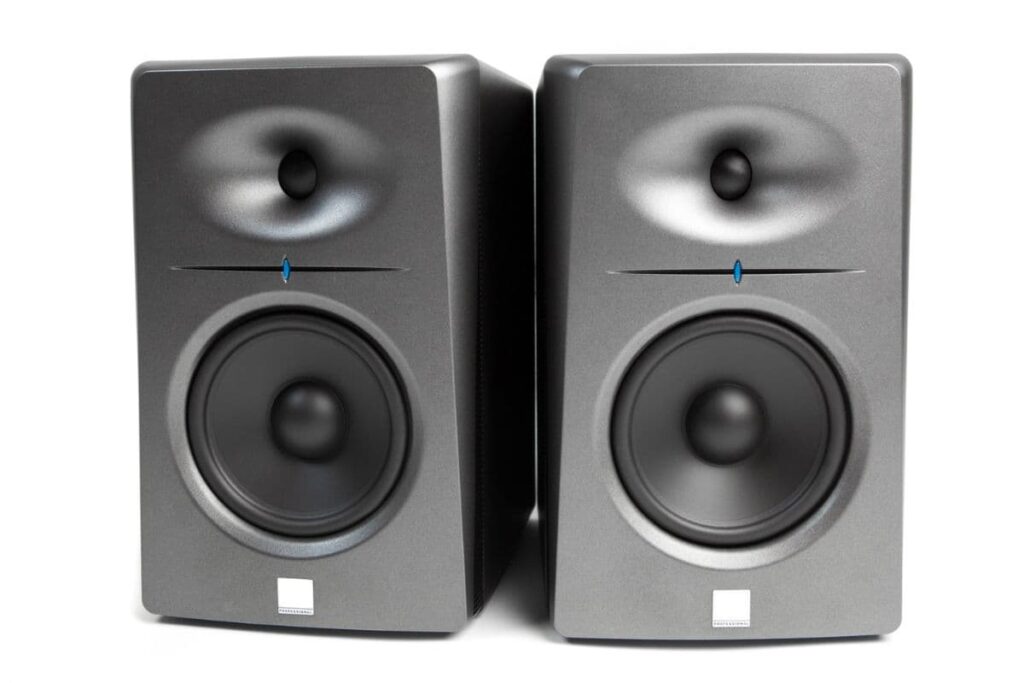Your studio monitors are a central reference point for everything you hear while recording or mixing. Maybe you have a target volume where you know the mix sounds its best, or perhaps a certain volume level never sounds good. Whatever it is, there’s most likely a sweet spot for monitoring your music, but should you turn your monitors up?
You should not turn studio monitors all the way up because they can become too loud to listen to for extended periods. Clipping and distortion may also arise when you turn the volume up. Studio monitors are different; what works for one speaker won’t necessarily work for another.
Every speaker has an ideal volume range to get the most out of it. In other words, some speakers sound bad when you turn them up all the way, and others are not so clear to catch transients and other little details in the mix. This article will focus on why you shouldn’t turn your monitors all the way up and what to do instead.
Table of Contents
- Why You Shouldn’t Turn Your Monitors All the Way Up
- Adjusting Your Monitor Volume During Recording
- What To Do Before You Start Recording
- Conclusion

Why You Shouldn’t Turn Your Monitors All the Way Up
You might be tempted to increase the volume to ensure you can hear every little detail. While this won’t damage your hearing to the extent of blasting music at a high volume, it can still be harmful.
Research backs this up; turning up your monitor’s volume above 70 dB (decibels) can damage your hearing, cause fatigue, and trigger stress.
Additionally, you might find it harder to concentrate as you have to listen to external noise at a higher volume.
It’s easy to forget your speakers when you’re so focused on what’s happening on your screen. But turning your speakers up too high can damage them.
Loud sounds consume more amp power, and pushing an amplifier too hard can cause clipping, which, in turn, can potentially damage your speakers.
While turning your monitors too high is not suitable, don’t turn them too low either. You don’t want to be hearing all the fan noise, air conditioner noise, and other things going on in your room.
Adjusting Your Monitor Volume During Recording
You need to find a good balance between clearing out the room noise and hearing. How, you might ask?
- The first is with monitor placement. The speakers should face you, and you should be equidistant from each one. That way, you will hear the same sound in both ears at the same level, and you won’t have as much room noise getting in the way. Some people turn their monitors sideways for several reasons, which I’ve discussed in a separate article. Why Do People Turn their Studio Monitors Sideways?
- The second is with adjusting the volume in dB. The general rule of thumb is to keep the volume at or below 80-85 dB. As loudness increases past the optimal level, the quality of your audio decreases. At very high volumes, you may experience clipping, which is a distortion of the audio signal. Too much clipping results in a very harsh-sounding, almost unlistenable audio track.
- The third is monitor calibration. Studio monitor calibration is a topic discussed in a more extensive article. Calibrating a studio will help you hear exactly what you are recording or mixing. This will help you avoid over or under-EQing your recordings.
Speaker calibration aims to adjust the sound pressure levels coming out of your speakers to represent an accurate stereo image. We’ve outlined a few steps to follow:
- Turn your monitors all the way down (volume to zero).
- Set your gear (interface, amp, preamp) to an output of 0dB (also called the unity gain). The unity gain allows the audio input level on the device to be equal to the output on the same device.
- Place your SPL meter in your listening position and set it to C-weighted and slow response.
- Play a -20 dB pink noise and adjust your monitors one at a time until each reaches a 75-85 dB volume.
You can also adjust the volume on each monitor individually. Every room is different, but with a little calibration, you may find the “sweet spot” for mixing.
I also recommend reading my full guide on comparing studio monitors and speakers. You’ll learn everything about their designs and purpose. Studio Monitors vs. Speakers – Everything You Need To Know
What To Do Before You Start Recording
You should always check your studio monitors to ensure they are not popping or humming before you start recording. As your ears naturally warm up as you start recording, you want to ensure you listen at a comfortable volume.
You can always turn the volume knob up if the volume is too low. If it’s too loud, you can always turn it down.
Find the Right Volume for You
Different audio experts like to work at different volumes. Some like to work at lower volumes that are soft on their ears, and others like to work at very high volumes.
Your work volume should be based on what works best for you. There are no rules when it comes to mixing and recording. There are only guidelines that you can use to help you make the best possible decision for your music.
EQing
You might want to try some EQ settings before you really get into recording. Some people may call this “pre-EQing” their monitors, but I don’t like that term because it doesn’t accurately reflect this meaning. It’s advisable to try out different settings to see which one sounds best.
You can also do this with the track or the master fader. If you aren’t sure what frequencies you want to cut or boost, don’t hesitate to ask a professional.
Take Advantage of Headroom
Generally, you want to turn up your monitors above where you want them to be. Having a decent amount of headroom is important for a few different reasons. First, it will help prevent clipping and distortion. If you hit the max volume, your sound will be distorted, which is bad.
If you have headroom, it allows the sound to swell suddenly past the max volume without distorting. That way, you don’t have to worry about clipping and can focus on getting a good mix.
Conclusion
Monitoring is one of the most important steps in mixing, as this is where you can catch phase issues, frequencies that are too hot or too soft, and listen for anything out of place. Ideally, you want to have monitors set at a low volume so that you can focus on the sound itself instead of how loud it is.
- Review of the ALABS IRON MINI-WL: A Powerhouse Wireless Microphone - October 4, 2023
- What is a Saturator in Music Production: A Brief Explanation - May 11, 2023
- What Are Rotary DJ Mixers? An Overview - May 11, 2023
SoundStudiomagic.com is a participant in the Amazon Services LLC Associates Program, an affiliate advertising program designed to provide a means for sites to earn advertising fees by advertising and linking to Amazon.com. We also participate in other affiliate programs which compensate us for referring traffic.

